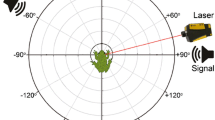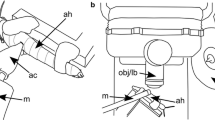Summary
The inner ear of the leopard frog,Rana pipiens, receives sound via two separate pathways: the tympanic-columellar pathway and an extratympanic route. The relative efficiency of the two pathways was investigated. Laser interferometry measurements of tympanic vibration induced by free-field acoustic stimulation reveal a broadly tuned response with maximal vibration at 800 and 1500 Hz. Vibrational amplitude falls off rapidly above and below these frequencies so that above 2 kHz and below 300 Hz tympanic vibration is severely reduced. Electrophysiological measurements of the thresholds of single eighth cranial nerve fibers from both the amphibian and basilar papillae in response to pure tones were made in such a way that the relative efficiency of tympanic and extratympanic transmission could be assessed for each fiber. Thresholds for the two routes are very similar up to 1.0 kHz, above which tympanic transmission eventually becomes more efficient by 15–20 dB. By varying the relative phase of the two modes of stimulation, a reduction of the eighth nerve response can be achieved. When considered together, the measurements of tympanic vibration and the measurements of tympanic and extratympanic transmission thresholds suggest that under normal conditions in this species (1) below 300 Hz extratympanic sound transmission is the main source of inner ear stimulation; (2) for most of the basilar papilla frequency range (i.e., above 1.2 kHz) tympanic transmission is more important; and (3) both routes contribute to the stimulation of amphibian papilla fibers tuned between those points. Thus acoustic excitation of the an uran's inner ear depends on a complex interac tion between tympanic and extratympanic sound transmission.
Similar content being viewed by others
Abbreviations
- dB SPL :
-
decibels sound pressure level re: 20 μN/ m2
- AP :
-
amphibian papilla
- BP :
-
basilar papilla
- BEF :
-
best excitatory frequency
References
Aertsen, AMHJ, Vlaming MSMG, Eggermont JJ, Johannesma PIM (1986) Directional hearing in the grassfrog (Rana temporaria L.). II. Acoustics and modelling of the auditory periphery. Hearing Res 21:17–40
Anson M, Pinder AC, Keating MJ, Chung S-H (1985) Acoustic vibration of the amphibian eardrum studied by white noise analysis and holographic interferometry. J Acoust Soc Am 78:916–923
Békésy G von (1948) Vibration of the head in a sound field and its role in hearing by bone conduction. J Acoust Soc Am 20:749–760
Békésy G von (1949) The structure of the middle ear and the hearing of one's own voice by bone conduction. J Acoust Soc Am 21:217–232
Békésy G von (1960) Experiments in hearing. McGraw-Hill, New York
Capranica RR (1976) Morphology and physiology of the auditory system. In: Llinás R, Precht W (eds) Frog neurobiology. Springer, Berlin Heidelberg New York, pp 551–575
Capranica RR, Moffat AJM (1975) Selectivity of the peripheral auditory system of spade foot toads (Scaphiopus couchi) for sounds of biological significance. J Comp Physiol 100:231–249
Carlile S, Pettigrew AG (1984) Auditory responses in the torus semicircularis of the cane toad,Bufo marinus. II. Single unit studies. Proc R Soc Lond B222:243–257
Chung S-H, Pettigrew AG, Anson M (1978) Dynamics of the amphibian middle ear. Nature 272:142–147
Chung S-H, Pettigrew AG, Anson M (1981) Hearing in the frog: dynamics of the middle ear. Proc R Soc Lond B212:459–485
Dooling RF (1980) Behavior and psychophysics of hearing in birds. In: Popper AN, Fay RR (eds) Comparative studies of hearing in vertebrates. Springer, Berlin Heidelberg New York, pp 261–288
Dragsten PR, Webb WW, Paton JA, Capranica RR (1974) Auditory membrane vibrations: measurements at sub-Angtröm levels by optical heterodyne spectroscopy. Science 185:55–57
Feng AS (1982) Quantitative analysis of intensity-rate and intensity-latency functions in peripheral auditory nerve fibers of northern leopard frogs (Rana p. pipiens). Hearing Res 6:241–246
Feng AS, Narins PM, Capranica RR (1975) Three populations of primary auditory fibers in the bullfrog (Rana catesbeiana): Their peripheral origins and frequency sensitivities. J Comp Physiol 100:221–229
Feng AS, Shofner WP (1981) Peripheral basis of sound localization in anurans. Acoustic properties of the frog's ear. Hearing Res 5:201–216
Håkansson B, Tjellstrom A, Rosenhall U (1984) Hearing thresholds with direct bone conduction versus conventional bone conduction. Scand Audiol 13:3–13
Hartline PH (1971a) Mid-brain responses of the auditory and somatic vibration systems in snakes. J Exp Biol 54:373–390
Hartline PH (1971b) Physiological basis for detection of sound and vibration in snakes. J Exp Biol 54:349–371
Heffner HE, Heffner RS (1985) Hearing in two cricetid rodents: Wood rat (Neotoma floridana) and grasshopper mouse (Onychomys leucogaster). J Comp Psychol 99:275–288
Hetherington TE, Lombard RE (1983) Electromyography of the opercularis muscle of Rana catesbeiana: An amphibian tonic muscle. J Morphol 175:17–26
Lewis ER, Baird RA, Leverenz EL, Koyama H (1982) Inner ear: dye injection reveals peripheral origins of specific sensitivities. Science 215:1641–1643
Lombard RE, Straughan IR (1974) Functional aspects of anuran middle ear structures. J Exp Biol 61:71–93
Lowy K (1942) Cancellation of the electrical cochlear response with air and bone-conducted sound. J Acoust Soc Am 14:156–158
Mardia KV (1972) Statistics of directional data. Academic Press, London New York
Moffat AJM, Capranica RR (1978) Middle ear sensitivity in anurans and reptiles measured by light scattering spectroscopy. J Comp Physiol 127:97–107
Møller AR (1972) The middle ear. In: Tobias JV (ed) Foundations of modern auditory theory, vol II. Academic Press, New York, pp 135–194
Pettigrew AG, Carlile S (1984) Auditory responses in the torus semicircularis of the cane toad,Bufo marinus. I. Field potential studies. Proc R Soc Lond B222:231–242
Pettigrew AG, Anson M, Chung S-H (1981) Hearing in the frog: A neurophysiological study of the auditory response in the midbrain. Proc R Soc Lond B212:433–457
Pinder AC, Palmer AR (1983) Mechanical properties of the frog ear: vibration measurements under free and closed field acoustic conditions. Proc R Soc Lond B219:371–396
Rheinlaender J, Walkowiak W, Gerhardt HC (1981) Directional hearing in the green treefrog: A variable mechanism? Naturwissenschaften 67:430–431
Ross RJ, Smith JJB (1980) Detection of substrate vibrations by salamanders: Frequency sensitivity of the ear. Comp Biochem Physiol 65:167–172
Saunders JC, Johnstone BM (1972) A comparative analysis of middle ear function in non-mammalian vertebrates. Acta Otolaryngol 73:353–361
Stebbins WC (1980a) The acoustic sense of animals. Harvard University Press, Cambridge
Stebbins WC (1980b) The evolution of hearing in mammals. In: Popper AN, Fay RR (eds) Comparative studies of hearing in vertebrates. Springer, Berlin Heidelberg New York, pp 421–436
Tonndorf J (1972) Bone conduction. In: Tobias JV (ed) Foundations of modern auditory theory, vol II. Academic Press, New York, pp 197–237
Vlaming MSMG, Aertsen AMHJ, Epping WJM (1984) Directional hearing in the grass frog (Rana temporaria L.): I. Mechanical vibrations of tympanic membrane. Hearing Res 14:191–201
Walkowiak W, Capranica RR, Schneider H (1981) A comparative study of auditory sensitivity in the genusBufo (Amphibia). Behav Process 6:223–237
Wever EG (1978a) Sound transmission in the salamander ear. Proc Natl Acad Sci USA 75:529–530
Wever EG (1978b) The reptile ear. Princeton University Press, Princeton
Wever EG (1985) The amphibian ear. Princeton University Press, Princeton
Wever EG, Lawrence M (1954) Physiological acoustics. Princeton University Press, Princeton
Wilczynski W, Capranica RR (1984) The auditory system of anuran amphibians. Prog Neurobiol 22:1–38
Wilczynski W, Resler C, Capranica RR (1981) A study of the mechanism underlying directional sensitivity of the anuran ear. Soc Neurosci Abstr 7:147
Wilczynski W, Zakon HH, Brenowitz EA (1984) Acoustic communication in spring peepers. Call characteristics and neurophysiological aspects. J Comp Physiol A 155:577–584
Zakon HH, Capranica RR (1981) An anatomical and physiological study of regeneration of the eighth nerve in the leopard frog. Brain Res 209:325–338
Author information
Authors and Affiliations
Rights and permissions
About this article
Cite this article
Wilczynski, W., Resler, C. & Capranica, R.R. Tympanic and extratympanic sound transmission in the leopard frog. J. Comp. Physiol. 161, 659–669 (1987). https://doi.org/10.1007/BF00605007
Accepted:
Issue Date:
DOI: https://doi.org/10.1007/BF00605007




